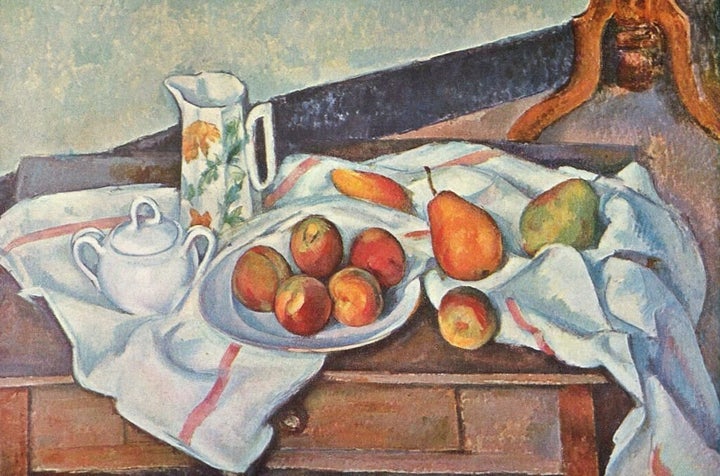
The video for “Fetish,” directed by Petra Collins, begins with Selena Gomez walking back to her suburban home as smoke billows from a wrecked car in the distance. There is a sense of looming disaster, or at least disarray, though the exact cause remains nebulous. In her hand, she holds a bag full of peaches.
Peaches are native to China, where they have grown wild for centuries. There, despite the fact that peach trees have a short lifespan, the plush fruits became symbols of immortality, in large part because of a Chinese myth that posited people who ate them were bestowed eternal life.
Today, peaches have acquired a different connotation, and for that, we have an emoji to thank. The seemingly omnipresent symbol ― a plump, heart-shaped object that appears to have two cheeks ― has, as eloquently stated on Know Your Meme, “gained notoriety for its visual similarity to a buttox.” It’s become synonymous with ass, giving poet T.S. Elliot’s 20th-century line “Do I dare to eat a peach?” a more salacious meaning.
In “Fetish,” released Wednesday, the camera flashes to Gomez’s hand as it weaves through the tangled leaves of a tree, grabbing for a peach. She examines its surface, woolly and purple.
On Urban Dictionary, peaches are nearly ubiquitously associated with vaginas. As one user wrote in 2007, “the juiciness, soft hair, and shape of the fruit obviously resemble the female vulva.” The association is fortified by certain colloquial quirks ― like the fact that nectarines are often dubbed “shaved peaches.” Though the two contemporary interpretations don’t quite converge, they certainly overlap. Peaches communicate sensuality, freshness, softness, femininity.
Cue “Fetish” again and Gomez arrives at an empty home in a state of indeterminate ruin. Two half-filled glasses of wine rest on the kitchen counter. The microwave is on. An inexplicable spread of ornate glass goblets filled with red and yellow liquids is arranged on the dining room table. She throws the bag of peaches against the wall.
In 1879, post-Impressionist painter Paul Cézanne created a painting called “Still Life: Plate of Peaches,” in which a cluster of peaches sit on a blue plate atop a white tablecloth. As was his custom, Cézanne painted his still lifes from a variety of vantage points at once. Instead of making representational depictions with natural light and shadow, the artist was interested in enchanting and nonsensical portraits of fruits as they exist only in the eyes of their maker. As an acquaintance of the artist recalled: “Cézanne set out the peaches in such a way as to make the complementary colors vibrate, grays next to reds, yellows to blues, leaning, tilting, balancing the fruit at the angles he wanted.”
One of the most prevalent motifs of Western art is the female nude. Cézanne, however, made peaches his muse, rendering them from a fantastical perspective where beauty superseded reality. And yet Cézanne didn’t prefer his peaches perfectly ripe. He preferred his fruits paradoxical, pink in some parts and bruised in others. To the artist, beauty was not equated with youth or perfection, but rather with complexity, contradiction, the impending promise of decay.

Back at Gomez’s house, things are not going well. She throws wine glasses and some rogue tomatoes onto the kitchen floor. She heaves and writhes, then proceeds to stuff things in her mouth that she probably shouldn’t, including soap, lipstick, glass and an eyelash curler. Gomez collapses into the domestic wreckage.
On July 21, Lana del Rey released her fifth album “Lust for Life,” a disorienting survey of American idols, mediated by drug-addled visions, bygone cliches, faded photos and groggily recalled dreams. On the song “13 Beaches” she sings: “With dripping peaches, I’m camera-ready most of the time,” toying with the fruits’ hyper-sexualized connotation. Exactly what the peaches refer to ― breasts, butt, beauty ― remains unclear. Because they make her “camera-ready,” they’re framed as eye candy, a thirst trap, a vision of idealized femininity projected upon her.
Her peaches come into play once again in the following song, “Cherry,” but here, things turn sour. ”’Cause I love you so much, I fall to pieces,” Del Rey croons. “My cherries and wine, rosemary and thyme / And all of my peaches are ruined.” What are peaches here, exactly? Do they represent, as Genius suggests, “sweeter joys”? Or, as millennial jargon would lead one to believe, tits and ass?
Del Rey is known for mixing metaphors, reorienting references and churning beautiful phrases that point to nothing. So maybe peaches don’t symbolize any one feeling in particular. In her review of the album, critic Meaghan Garvey likened the verse to “a Vanitas for contemporary America ― a still life of soft decay.” A modern-day Cézanne.

Return to Gomez, who has just discovered a massive freezer within her suburban home that holds within it ― what else? Peaches. She presses her body against the walls and floors, grazing the snow-covered fruits with her fingertips.
Peaches are, for the most part, desirable only when ripe ― not too young, not too aged. Yet their mythological origins conjure a longstanding association with eternal youth, a prolonged period of ripeness. Women, too, are prized in the perfect state of youth, a phase of life they’re expected to maintain despite nature’s best efforts. How does one preserve peaches, ass, desirability, femininity, etc.? According to Gomez, you stick them in the freezer.
The video concludes with Gomez playing around the giant freezer, making ice angels as if she were enjoying a snow day. There’s a palpable youthfulness to the whole bizarre exercise, a reminder that being a girl is about more than inhabiting a young body. It’s a way of moving through the world, a way of seeing and playing and loving. Alongside the preserved fruits, Gomez looks enchanted and full of joy, as if finally realizing this all can last forever.
Del Rey and Gomez offer two alternative models for peach handling. Del Rey welcomes the fruits’ inevitable decay. We’re already, as her lyrics state, “born to die.” Beauty fades, her songs suggest, but love saves. “Will you still love me / When I’m no longer young and beautiful?” In Del Rey’s world, flesh is a transient thing, but its ephemerality only adds to its romance.
Gomez, however, provides an alternative. Her video’s director, photographer and curator Petra Collins, is often hailed for her ability to capture “the female gaze” in her work. This is in part because of her giddily feminine aesthetic, as well as the adoring eye through which she captures and represents other young women. They’re depicted not quite sexually, but intimately, thanks to narrative clues that communicate her subjects are not objects but characters. Gomez, with her spilled wine and smashed tomatoes, is no different.
With “Fetish,” Collins and Gomez depict a femininity that transcends the female body. It’s present in the glittery way the sun hits the peach tree, or the gauzy glow of the dining room table, illuminated by candles for no apparent reason. The video is girly for reasons that transcend the two women. With its fuzzy edges and pinkish hue, the video is peachy itself.
Inside the world of “Fetish,” Gomez freezes her peaches, suggesting that girlhood can transcend nature’s plans for it. With the video, Collins proves her right. Like the peach emoji before it, Collins and Gomez show what happens when the idea of a thing becomes more powerful than the thing itself. That girlhood is not just a time of life but a way of looking and being in the world. That peaches can, as Chinese mythology once imagined, live forever.


You can be highbrow. You can be lowbrow. But can you ever just be brow? Welcome to Middlebrow, a weekly examination of pop culture. Read more here.
